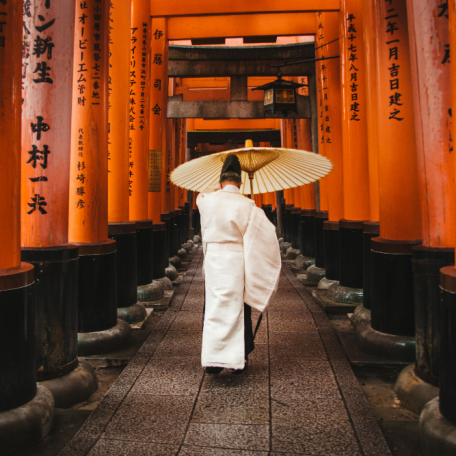Shirasu – A nutritious shoal of fish straight to your bowl
Nov 19, 2021
BY Philipp Reiher

In marine biology, fish are said to be shoaling when they swim in large groups as a precaution against predators or in order to save energy. However, without speaking disrespectfully, such a complex social group behavior does not apply to Shirasu (Jap. しらす, meaning whitebait), which refers to a catch-all phrase for tiny, immature fish typically eaten either raw or boiled and are often served together piled up on cooked rice. It is a purely simple dish that contains an intensive taste of the ocean’s finest flavors. Whether or not you call yourself a seafood-lover, you should definitely give Shirasu a try. But what exactly does Shirasu stands for?
Although Shirasu differs in size and species, the huge number of fish is what makes it such a unique part of Japanese cuisine. Shirasu mostly refers to white or almost translucent young Japanese sardines (maiwashi, Jap. まいわし), round herring (urumeiwashi, Jap. うるめいわ), or anchovies (katakuchiiwashi, Jap. かたくちいわし) that rarely exceed 2-3cm in length. These fish can be caught in coastal areas or estuaries where huge shoals of fish are seeking sheltered, shallow waters. Shirasu is mainly unprocessed, so you can eat the whole fish from head to tailfin. The skeletal structure of juvenile fish is not yet well developed, so you don’t have to fear getting a bone stuck in your throat. The texture is rather soft and tender, while the salty, mildly fishy taste clearly distinguishes its freshness.
Before the fish lands inside your bowl, there is a ton of hard work behind the scenes. Fishing Shirasu (the process itself is called whitebaiting) is a process where you are constantly pushed for time, as the race for the freshest Shirasu decides between whether the catch will be a profit or a loss. Whitebait can be harvested from around the globe, but they can differ remarkably in quality. In Japan, it is way more than just a mere delicacy. Shirasu has a robust history steeped in tradition and is deeply rooted in the culture. In modern times still, the demand has not faded. For instance, in 2016, the total catch of whitebait in Japan numbered 62,900 tons.

The wide range of nutritional benefits that Shirasu offer
As for their full-grown cold-water counterparts, all species that full under Shirasu contain fish oil that contains the well-known Omega-3 fatty acids (mainly docosahexaenoic acid (DHA) and eicosapentaenoic acid (EPA)), which are vital for human survival. There are numerous healthy effects Omega-3 fatty acids have on our blood, such as facilitating blood flow as well as anti-inflammatory characteristics. In addition, it is said that Omega-3 fatty acids serve the purpose of preventing a large number of diseases like cardiovascular disease, cancer, or rheumatoid arthritis. Another great benefit of Shirasu is its high amount of calcium, which is necessary for bone growth and muscle contraction and therefore is inextricably connected to sound health. What’s more, Shirasu contains a noteworthy amount of Vitamin D which facilitates intestinal absorption of various substances like calcium or magnesium and makes Shirasu part of a perfectly balanced meal to compensate for any lack of calcium. Of course, as with almost every white fish, Shirasu has many high-quality proteins to offer. As mentioned before, you will be rewarded with a wide range of nutritional benefits, and you can eat the whole fish in one bite. Below you can get a glimpse of the average nutritional value.
Amount per 100g boiled Shirasu (value might differ depending on product):
| Calories | 124kcal |
| Total Fat | 2,1g |
| Protein | 24,5g |
| Total Carbohydrate | 0,1g |
| Salt | 4,2g |
Where to experience the ultimate Shirasu taste?
It can be a bit of a wild-goose-chase watching out for restaurants that offer fresh Shirasu if you don’t know where to look or if you’re not visiting cities directly located in coastal areas. Similar to well-known Sashimi (Jap. さしみ、raw sliced fish, shellfish, or crustaceans), raw Shirasu has to be eaten shortly after it’s caught. To get the best impression of the freshest Shirasu, try to find a seafood restaurant that offers same-day-catch Shirasu. You’ll find a good catch by visiting Kamakura (Jap. 鎌倉, Kanagawa Prefecture) from April to late November since this is the main season for Shirasu. Kamakura is a spectacular seaside city (and former Japanese capital!) just south of Tokyo. After you visited the numerous beautiful temples and shrines, you can probably call yourself an expert of Zen-Buddhism (which is said to be initially taught in Kamakura after coming from China) and will certainly feel like you’re starving. This is your chance to try Kamakura’s flagship dish: a bowl of rice with Shirasu, called Shirasu-Don (Jap. しらす丼). You don’t have to walk miles to find restaurants that offer a great diversity of Shirasu, whether that be as a standalone bowl or mixing it together with different kinds of seafood and side dishes. Keep in mind that the availability of fresh Shirasu strongly depends on the weather and the daily fishing quota. The shorter the time between catch and consumption, the harder it will be to deny Shirasu’s ultimate freshness and taste.

How to use it by yourself?
Although a fresh bowl of Shirasu offers undoubtedly the finest quality, you can easily buy Shirasu nowadays in almost every supermarket and convenience store. Not only the classic raw, lightly dried Shirasuboshi (Jap. 白子干し), and strongly dried Chirimenjako (Jap. ちりめんじゃこ), but the boiled Shirasu as well, which can be mixed with plum or grapes fill out the repertoire of Shirasu products. Of course, this is a non-exhaustive list and sometimes, some of those names are used interchangeably, which can cause confusion among Shirasu newbies. Depending on where you are, the water content of boiled fish or the degree of drying may be different.

While Shirasu-Don might be the most famous way to enjoy Shirasu, you don’t necessarily have to eat it with cooked rice. Shirasu perfectly fits with salad, noodles, or even pizza. Your creativity has no limits when it comes to Shirasu. When Shirasu has been processed to oil, it gives your dishes a strong ocean-scented flavor, which perfectly matches with tons of dishes. Be sure to add neatly grated ginger, soy sauce, mirin (Jap. みりん, type of sweet rice wine used in cooking), or shiso (Jap. しそ, beefsteak plant) for the ultimate Shirasu experience. Protein-seeking sports enthusiasts can use whole-grain rice instead and further add raw salmon or grilled octopus. The simplicity Shirasu affords you to serve a magnificent and nutritious feast without wasting hour after hour inside your kitchen can make Shirasu a great alternative for your diet. Let this Japanese classic become your own fishermen’s favorite.

Learn more about the Top 5 Japanese foods you have to try during your trip to Japan!
PIN THIS FOR LATER
9
shares
Book your pocket wifi now to stay connected through your entire Japan Journey!

Be sure to get the JR Pass to make navigating Japan during your trip that much easier!

YOU MIGHT ALSO LIKE




